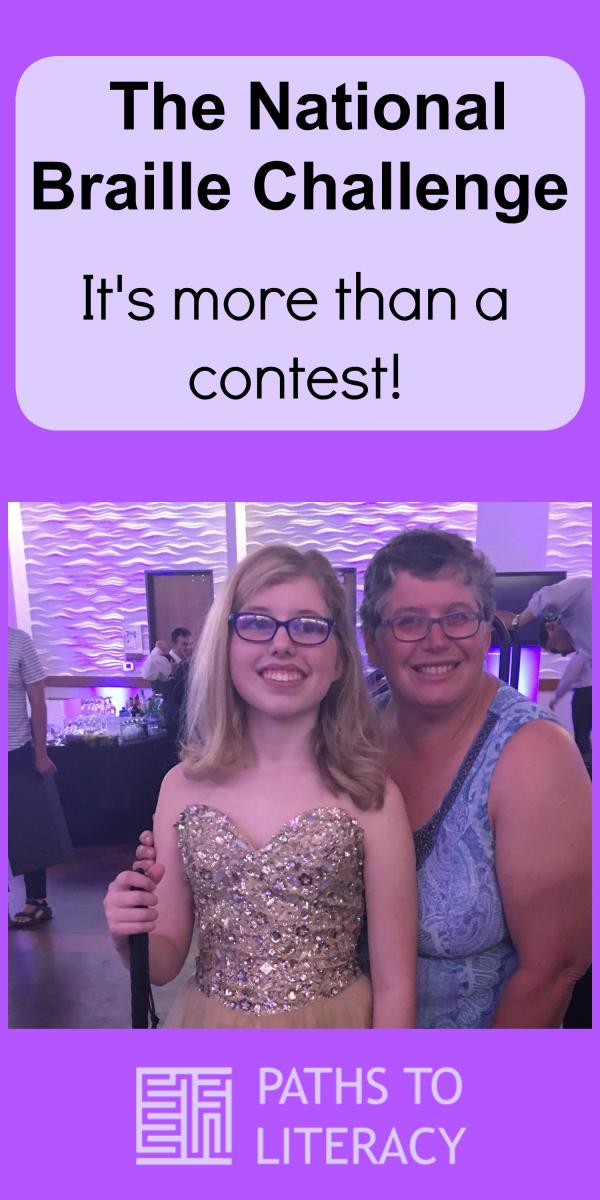It’s Much More Than a Contest…. My Observations from Attending the National Braille Challenge
As I stood chatting with Layla Hildenbrand, an 8-year-old Apprentice contestant from North Carolina wearing a beautiful pink dress, I heard two Freshman competitors harmonizing, a family talking about how impressive the University of Southern California was, and a father and son talking about getting to do a “guy trip”. We were all waiting for the shuttle bus to take us to the closing ceremony of the 2018 National Braille Challenge.
You can watch the ceremony and feel and see the excitement as anticipation mounts to find out who the winners are in each of the five grade group categories along with individual winners for spelling, reading comprehension, charts and graphs.
Teacher of the Year
Each year the Braille Institute, the creator and sponsor of this event in its 18th year, honors a Teacher of the Year. For 2018 Jeri Hile from Shawnee Mission Public Schools in Shawnee Mission, Kansas received this prestigious honor. The winner in each grade group category and the Teacher of the Year each receive a BrailleNote Touch donated by Humanware.
Challenges for Individuals Who Read "Differently"
 The Braille Challenge reminds me of my personal challenges as a child with low vision who “read differently.” Like many of the 1,100 students throughout the US and Canada who participated in 51 regional contests, I was the only student with a visual impairment in my school. Finding ways to excel and to be recognized for my strengths was never easy. The 50 finalists, this year from 27 states and British Columbia, each excel when it comes to braille literacy, and beyond. I met young people who want to be authors, lawyers, scientists, computer programmers, and more. I learned about their hobbies from scouting to track and field to robotics and of course reading!
The Braille Challenge reminds me of my personal challenges as a child with low vision who “read differently.” Like many of the 1,100 students throughout the US and Canada who participated in 51 regional contests, I was the only student with a visual impairment in my school. Finding ways to excel and to be recognized for my strengths was never easy. The 50 finalists, this year from 27 states and British Columbia, each excel when it comes to braille literacy, and beyond. I met young people who want to be authors, lawyers, scientists, computer programmers, and more. I learned about their hobbies from scouting to track and field to robotics and of course reading!
For me, as a person with a visual impairment, I have to say one of my favorite parts of this event is seeing contestants connect with other contestants. As a youth I found the connections I made through attending a summer camp to be valuable and still do to this day. Through coming together at nationals over the last several years, a group of teens now meet online each Sunday and have formed their own acapella choir. Each goes to public school, but each finds the time together fun and a way to connect with others who also love to sing, read braille, and use technology.
Getting to the National Braille Challenge
To make it to the National Braille Challenge and to be among the winners, contestants must work hard on their braille skills. In the same way athletes train for their sports, these young people train to ace competitions in spelling, proofreading, reading comprehension, dictation, charts and graphs. I can tell you that their papers are scored meticulously – I got to be part of the scoring room crew this year. Luckily, they had lots of chocolate on hand to keep my energy level up! The number of volunteers (braille transcribers, teachers of students with visual impairments, Braille Institute volunteers, local business volunteers, and countless others) the Braille Institute pulls together to make this event a success is amazing. My hat's off to Sergio Oliva, Marie Saldivar, Christine Pak, and the many others at Braille Institute who are the muscle behind the event and work tirelessly year round to make the regionals and nationals a success.
And, by the way, Layla Hildenbrand from North Carolina won second place for Apprentice. Ciara Peterson from Tucson, Arizona, whose mother took a braille literacy class with me when Ciara was a preschooler, won second place for the Sophomores, and Kaleigh Brendle, from my hometown of Freehold, New Jersey, won first place for the Junior Varsity.
Braille Is Knowledge and Knowledge Is Power

